ASM Metals HandBook Vol. 14 - Forming and Forging
Подождите немного. Документ загружается.

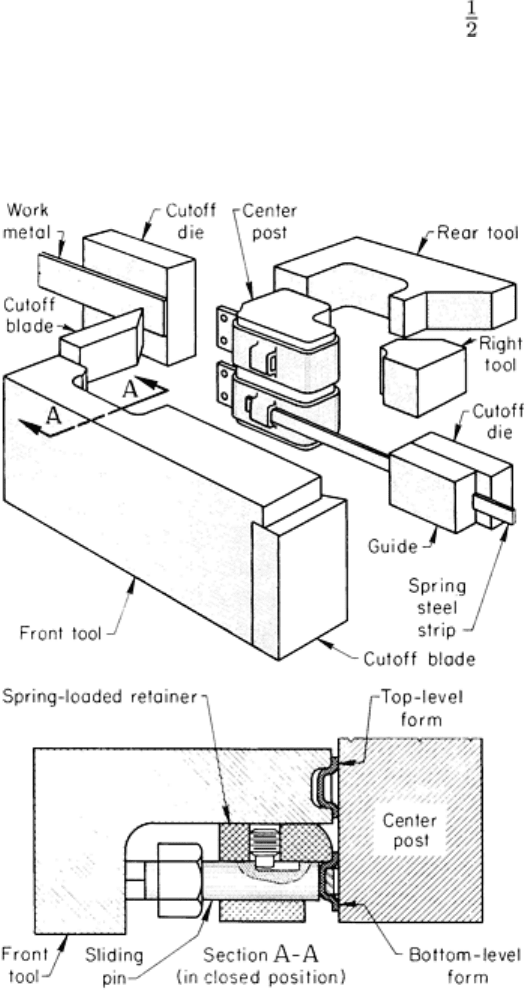
By means of auxiliary feeding attachments, one or more components can be assembled to a part being formed during the
same machine cycle. Hopper feeding units can sort and orient machined or previously formed parts for feeding into the
part being formed in the multiple-slide machine. These devices can be arranged to feed horizontally adjacent to any
forming slide, or can be operated vertically.
Hopper feeding involves the automatic sorting and transfer of components placed randomly in a hopper of suitable
design and shape for delivery by gravity to a track, correctly positioned and in ordered sequence to a machine.
Production Practice. Figure 9 shows the assembly of a flat steel spring into a small steel bracket at the lower level of a
two-level multiple-slide machine operation. The bracket was made from 12.7 mm ( in.) wide stock 0.76 mm (0.030 in.)
thick. In the press station, the two holes were pierced, and the lug was slit and raised. The bracket was bent to shape
around the center post at the top level by the action of the front, rear, and right forming tools. It was then moved to the
bottom forming level by the stripper and held in position against the center post by a spring-loaded retainer. A sliding pin
mounted in the retainer was used to flatten the lug against the spring steel strip.
Fig. 9 Assembly of spring steel strip into a bracket at the bottom level of a two-level multiple-
slide forming
operation.
The spring steel strip was fed into the recess formed by the lug. The front tool then moved in, contacted the sliding pin,
flattened the lug, secured the strip to the bracket, and at the same time severed the spring steel strip by a blade mounted to
the front tool.
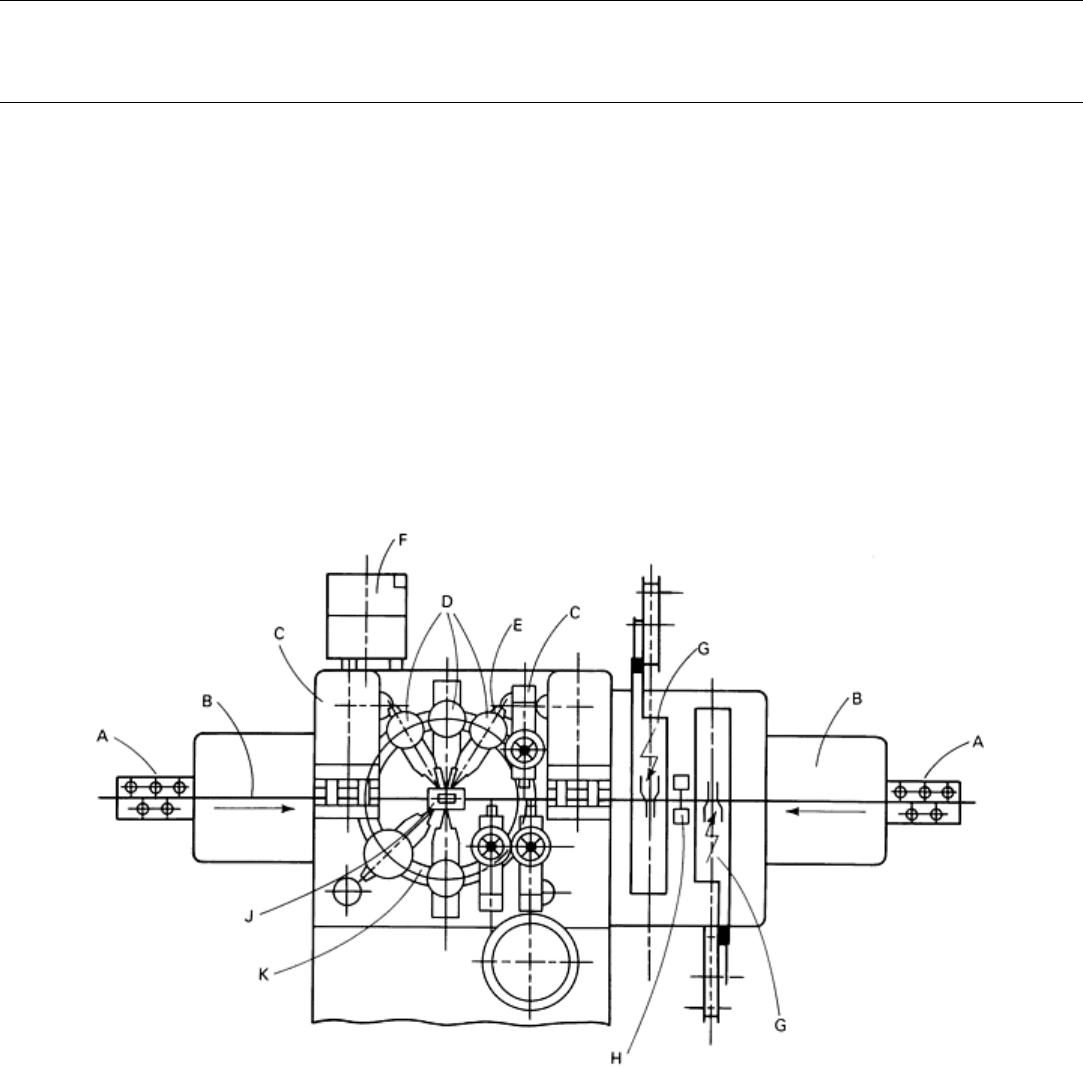
On the next cycle, the assembly was ejected from the center post by the downward movement of the succeeding
component. The lower part of the spring-loaded retainer was cut away to clear the strip as it was fed into the lug and to
permit ejection.
Forming of Steel Strip in Multiple-Slide Machines
Revised by Deborah A. Blaisdell, The U.S. Baird Corporation
Multiple-Slide Rotary Forming Machines
The multiple-slide rotary forming machine with open planetary gearing is simple in concept and design. In this type of
machine, the slides are driven by a central gear wheel, and the central forming motions are controlled by cams.
Figure 10 shows a schematic of a multiple-slide rotary forming machine. The material is first uncoiled from the reel, then
pulled through the straightening station (A) by the material feeder (B). It is then fed to the press (C) and forming slides
(D), where the workpieces are formed and ejected. Recessed rails guide the material between the feeder and the stamping
station, as well as between the cutting and forming stations. Here, the blanks are either completely stamped out in the
press and then pushed into the bending station by the following material, or they remain attached to the strip by means of
a web that is not completely separated until it reaches the final forming station. Material feed, stamping presses, forming
slides, and operation of the central tool are synchronously coupled to each other.
Fig. 10 Schematic of a multiple-
slide rotary forming machine. A, straightening stations; B, feed mechanism; C,
stamping stations; D, formin
g tools; E, thread tapping unit; F, station for feeding and assembling; G, welding
stations; H, sizing unit; J, standard forming tool guide; K, central gear wheel.
See text for description of
operation.
Auxiliary Equipment. A second material feed and press, a part-feeding mechanism, three thread-tapping units, and
two welding units can be added to a multiple-slide rotary forming machine (Fig. 10). It is possible to have additional
material feeds from the front and rear sides. Additional cam motions allow forming slides and standardized tools to be
mounted on the rear side of the bed in the forming area. Machined assembly surfaces on the bed and cover plate offer
further possibilities for fastening attachments.

Standardized Tooling. The forming tool guide (the basic tool) consists of the tool plate with a central slider for one or
more tools (Fig. 11). Forming tools are suspended in the tool holders mounted on the forming slides, which can be easily
inserted or removed. In operation, the tool guide is enclosed by a cover plate, with an opening at its center for ejection of
the working piece. Control cams drive the forming slides and consist of two complementary disk cams.
Fig. 11 Standard forming tool guides for multiple-slide rotary forming machines.
Deep Drawing
Introduction
DEEP DRAWING of metal sheet is used to form containers by a process in which a flat blank is constrained while the
central portion of the sheet is pressed into a die opening to draw the metal into the desired shape without folding of the
corners. This generally requires the use of presses having a double action for hold-down force and punch force. The
process is capable of forming circular shapes, such as cooking pans, box shapes, or shell-like containers. The term deep
drawing implies that some drawing-in of the flange metal occurs and that the formed parts are deeper than could be
obtained by simply stretching the metal over a die. Clearance between the mate punch and the female die is closely
controlled to minimize the free span so that there is no wrinkling of the sidewall. This clearance is sufficient to prevent
ironing of the metal being drawn into the sidewall in the deep-drawing process. If ironing of the walls is to be part of the
process, it is done in operations subsequent to deep drawing.
Suitable radii in the punch bottom to side edge, as well as the approach to the die opening, are necessary to allow the
metal sheet to be formed without tearing. In most deep-drawing operations, the part has a solid bottom to form a container
and a retained flange that is trimmed later in the processing. In some cases, the cup shape is fully drawn into the female
die cavity, and a straight-wall cup shape is ejected through the die opening. To control the flange area and to prevent
wrinkling, a hold-down force is applied to the blank to keep it in contact with the upper surface of the die. A suitable
subpress or a double-action press is required. Presses can be either hydraulic or mechanical devices, but hydraulic presses
are preferred because of better control of the rate of punch travel.
Any metal that can be processed into sheet form by a cold-rolling process should be sufficiently ductile to be capable of
deep drawing. Both hot- and cold-rolled sheet products are used in deep-drawing processes. The cold-work effects
introduced during processing of the sheet products for deep-drawing applications must be removed (by annealing, for
example), and the as-delivered coils should be free of any aging. This would imply that an aluminum-killed drawing-
quality steel, for example, would be preferred over a rimmed steel. After the deep-drawing operation, ductility can be
returned to that of the original sheet by in-process annealing, if necessary. In many cases, however, metal that has been
deep drawn in a first operation can be further reduced in cup diameter by additional drawing operations, without the need
for intermediate annealing.
The properties considered to be important in sheet products designed for deep drawing include:
•
Composition, with a minimum amount of inclusions and residual elements contributing to better
drawability
• Mechanical properties, of which the elongation as measured in a tension test, the plastic-strain ratio r
(see the section "Drawability" in this article), and the strain-hardening exponent n
are of primary
importance. The strength of the final part as measured by yield strength must also be considered, but
this is more a function of the application than forming by deep drawing
• Physical properties, inclu
ding dimensions, modulus of elasticity, and any special requirements for
maintaining shape after forming
Once a metal has been deep drawn into a suitable form, it can be further processed to develop additional shape. The first
shape is usually a round cylinder, or a modification of this--a square box with rounded corners, for example. This latter
shape is related to the cylinder in that the four corners are essentially quarter segments with straight walls between each
segment.
For small cylinders, a relationship between the diameter of a circular blank and the bottom diameter of the cup shape to
be formed is sometimes used to measure deep drawability. The most commonly referred to cup test for deep drawing is
the Swift cup test, which uses a 2 in. (50 mm) diam flat-bottomed punch to form test blanks. For ductile low-carbon steel,
aluminum, and brass sheets, a 102 mm (4 in.) circular blank can be formed in a single draw. Increased plastic strain ratio r
and ductility allow larger blanks to be drawn successfully; the limit is reached when the bottom punches out, rather than
forming a cup shape. The blank diameter divided by the punch diameter gives the limiting draw ratio (LDR), which for
the above examples would be 2. More information on the Swift cup test is available in the article "Formability Testing of
Sheet Metals" in this Volume.
Of the commonly formed metals, brass and austenitic stainless steels show high limiting draw ratios (up to 2.25). A few
samples have reached a value of 2.5 to produce a cup with a sidewall height of nearly 64 mm (2.5 in.). This is possible,
although the total length of the cup cross section would be 179 mm (7 in.), which is more than the blank diameter because
of the deep-drawing forces. The interstitial-free steels, which have average r values of 2.5 or higher, can be deep drawn to
limiting draw ratios near 2.5. With these extremely deep draws, sidewall delayed splitting must be prevented by such
means as stress-relief annealing immediately following the drawing operation.
The thickness of the work metal does not change appreciably in deep drawing; therefore, the surface area of the final part
is about the same as that of the initial blank. As the metal in the flange area is drawn into the die opening over the
approach radius, it is subjected to radial tension and, concurrently, to circumferential compression. This explains why a
127 mm (5 in.) diam blank with a surface area of 126 cm
2
(19.6 in.
2
) can form a cup shape 64 mm (2.5 in.) deep that has a
total surface area of about 121 cm
2
(18.8 in.
2
).
With proper balance among the punch force, the hold-down force, and the strength of the metal sheet being formed, a cup
shape can be developed. At the start of this process, the metal in the free area between the punch bottom and the flange
hold-down is stretched and wrapped over the nose of the punch and the approach radius of the die. During this stretching,
strain hardening strengthens the metal. If it is not capable of such strengthening or if its strength at any location is
exceeded at any time during the forming, the bottom of the cup shape will break out. Contributing to this strengthening is
a high r value, which is a measure of resistance to through-thickness changes in the metal sheet. If the metal has a high
resistance to thinning and thickening, the bottom radius and the upper sidewall areas retain close to their original
thickness, and the radial and circumferential strains obtainable in the drawn-in flange are increased to accommodate the
deep-drawing process.
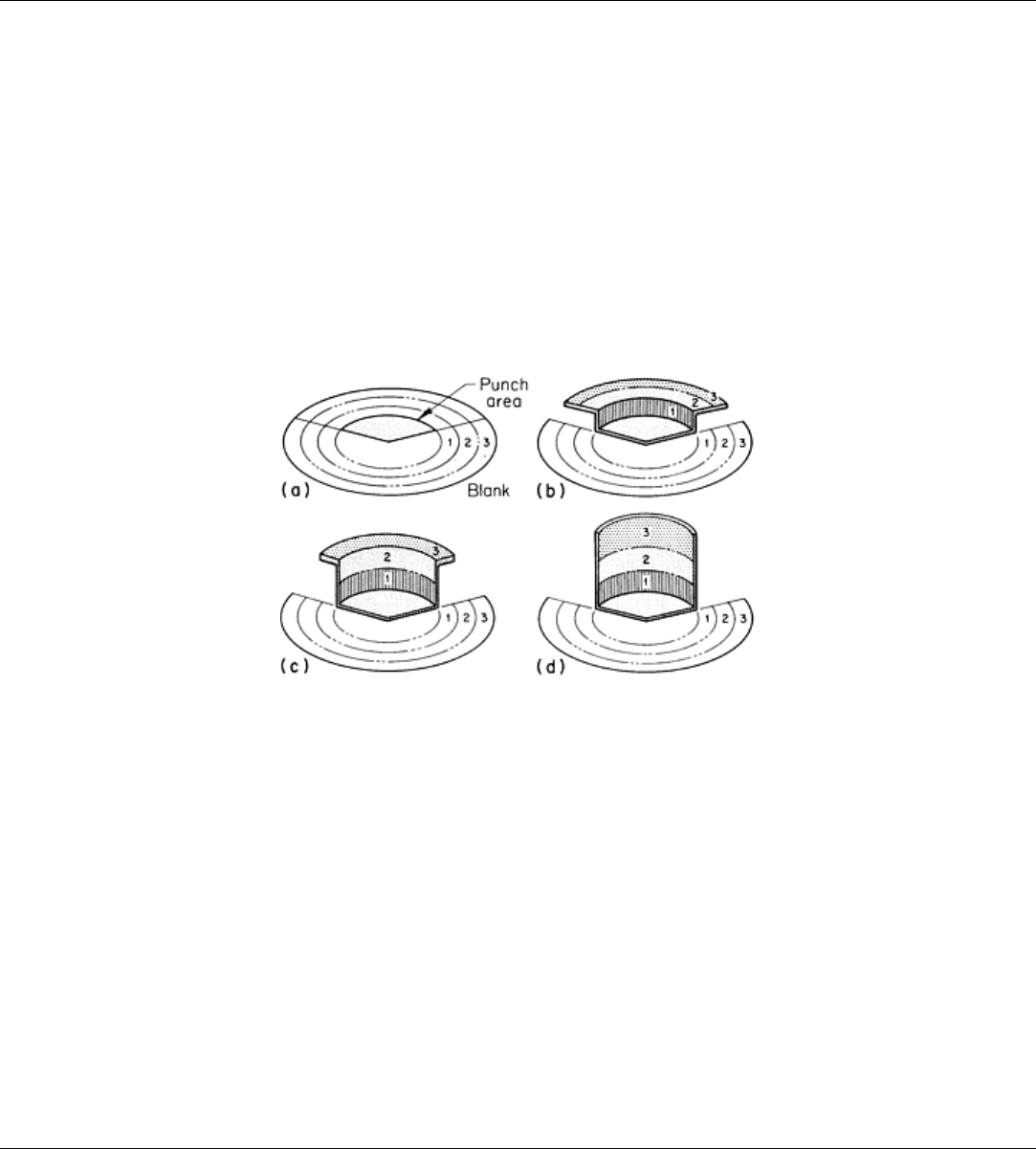
After the bottom has been stretch formed, the clearance between the punch and die is such that the metal in the cup side is
free to move without excessive rubbing on the die walls. It has been found that slight roughening of the punch radius and
minimizing the lubrication of this area contribute to deeper drawability; however, the die opening should be smooth and
well lubricated with a suitable drawing compound.
Deep Drawing
Fundamentals of Drawing
A flat blank is formed into a cup by forcing a punch against the center portion of a blank that rests on the die ring. The
progressive stages of metal flow in drawing a cup from a flat blank are shown schematically in Fig. 1. During the first
stage, the punch contacts the blank (Fig. 1a), and metal section 1 is bent and wrapped around the punch nose (Fig. 1b).
Simultaneously and in sequence, the outer sections of the blank (2 and 3, Fig. 1) move radially toward the center of the
blank until the remainder of the blank has bent around the punch nose and a straight-wall cup is formed (Fig. 1c and d).
During drawing, the center of the blank (punch area, Fig. 1a) is essentially unchanged as it forms the bottom of the drawn
cup. The areas that become the sidewall of the cup (1, 2, and 3, Fig. 1) change from the shape of annular segments to
longer parallel-side cylindrical elements as they are drawn over the die radius. Metal flow can occur until all the metal has
been drawn over the die radius, or a flange can be retained.
Fig. 1 Progression of metal flow in drawing a cup from a flat blank.
A blankholder is used in a draw die to prevent the formation of wrinkles as compressive action rearranges the metal from
flange to sidewall. Wrinkling starts because of some lack of uniformity in the movement or because of the resistance to
movement in the cross section of the metal. A blankholder force sufficient to resist or compensate for this nonuniform
movement prevents wrinkling. Once a wrinkle starts, the blankholder is raised from the surface of the metal so that other
wrinkles can form easily. The force needed to hold the blank flat during drawing of cylindrical shells varies from
practically zero for relatively thick blanks to about one-third of the drawing load for a blank 0.76 mm (0.030 in.) thick.
Thinner blanks often require proportionally greater blankholder force.
Conditions for drawing without a blankholder depend on the ratio of the supported length of the blank to its thickness, the
amount of reduction from blank diameter to cup diameter, and the ratio of blank diameter to stock thickness. For thick
sheets, the maximum reduction of blank diameter to cup diameter in drawing without a blankholder is about 25%. This
ratio approaches zero for thin foil-like sheet. If a blankholder is employed, the maximum reduction is increased to about
50% for metals of maximum drawability and 25 to 30% for metals of marginal drawability in the same equipment.
Deep Drawing
Drawability
In an idealized forming operation--that is, one in which drawing is the only deformation process that occurs--the
blankholder force is just sufficient to permit the work material to flow radially into the die cavity without wrinkling.
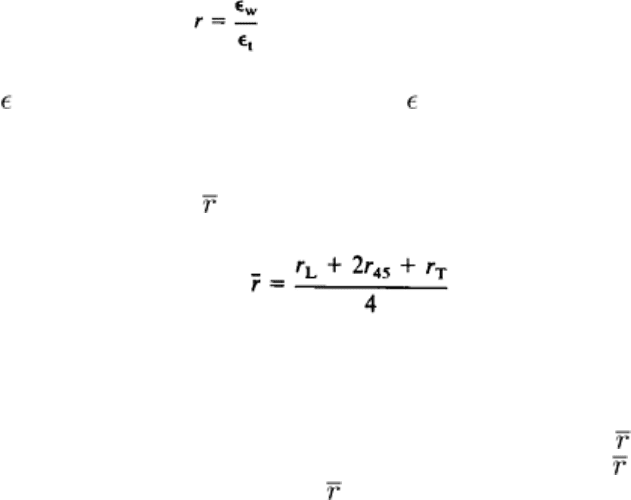
Deformation takes place in the flange and over the lip of the die. No deformation occurs over the nose of the punch. The
deep-drawing process can be thought of as analogous to wire drawing in that a large cross section is drawn into a smaller
cross section of greater length.
The drawability of a metal depends on two factors:
• The ability of the material in the flange region to flow easily in the plane of the sheet under shear
• The ability of the sidewall material to resist deformation in the thickness direction
The punch prevents sidewall material from changing dimensions in the circumferential direction; therefore, the only way
the sidewall material can flow is by elongation and thinning. Thus, the ability of the sidewall material to withstand the
load imposed by drawing down the flange is determined by its resistance to thinning, and high flow strength in the
thickness direction of the sheet is desirable.
Taking both of these factors into account, it is desirable in drawing operations to maximize material flow in the plane of
the sheet and to maximize resistance to material flow in a direction perpendicular to the plane of the sheet. Low flow
strength in the plane of the sheet is of little value if the work material also has low flow strength in the thickness direction.
The flow strength of sheet metal in the thickness direction is difficult to measure, but the plastic-strain ratio r compares
strengths in the plane and thickness directions by determining true strains in these directions in a tension test. For a given
metal strained in a particular direction, r is a constant expressed as:
(Eq 1)
where
w
is the true strain in the width direction and
t
is the true strain in the thickness direction.
Sheet metal is anisotropic, that is, the properties of the sheet are different in different directions. It is therefore necessary
to use the average of the strain ratios measured parallel to, transverse to, and 45° to the rolling direction of the sheet to
obtain an average strain ratio , which is expressed as:
(Eq 2)
where r
L
is the strain ratio in the longitudinal direction, r
45
is the strain ratio measured at 45° to the rolling direction, and
r
T
the strain ratio in the transverse direction.
If flow strength is equal in the plane and thickness directions of the sheet, = 1. If strength in the thickness direction is
greater than average strength in the directions in the plane of the sheet, > 1. In this latter case, the material resists
uniform thinning. Generally, the higher the value, the deeper the draw that can be achieved (Fig. 2).
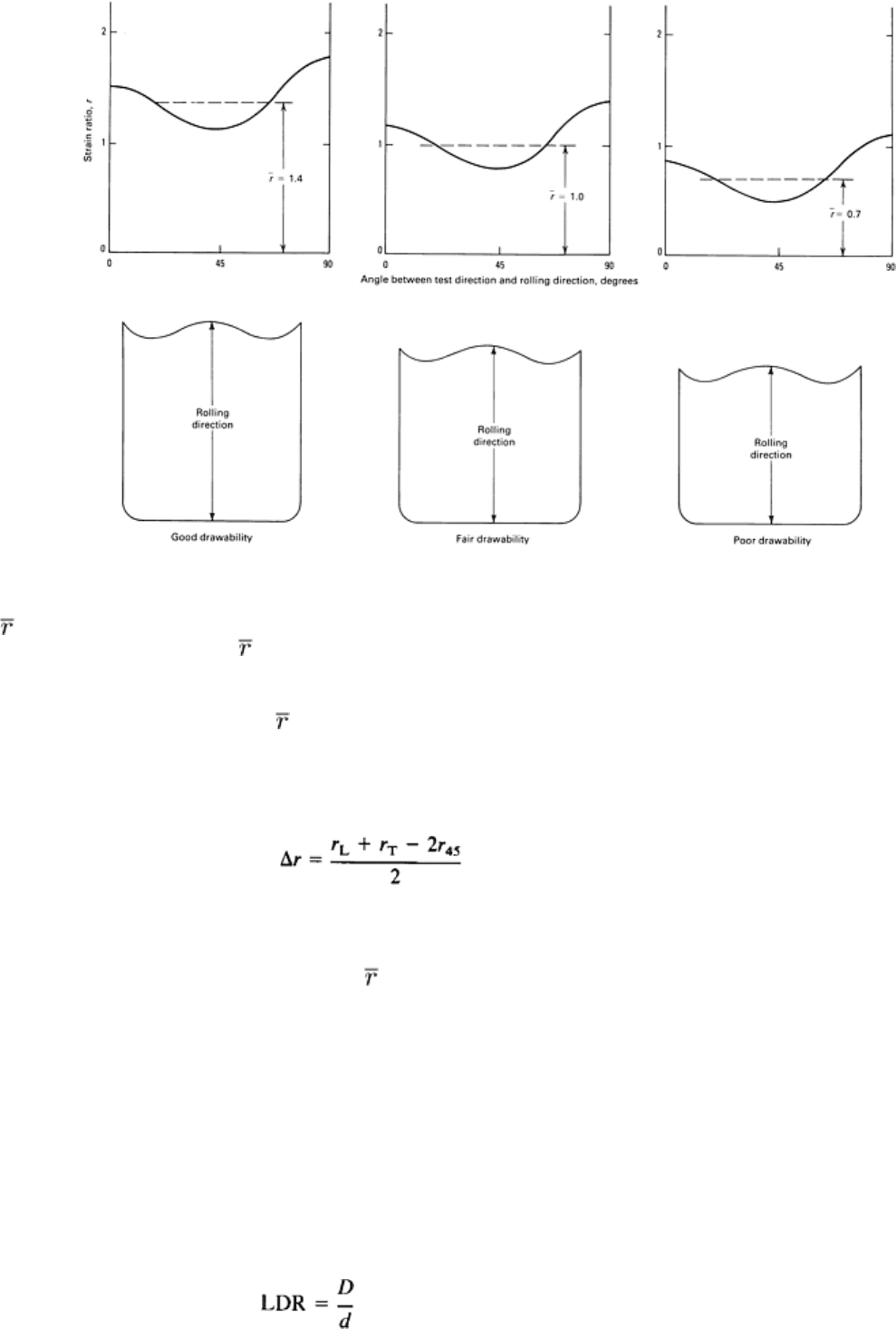
Fig. 2 Variation of strain ratio r with direction in low-
carbon steel (top curves) and effect of average strain ratio
on drawability of cylindrical cups (bottom). Each cup represents the deepest cup that can be drawn from
material with the indicated .
Because the average strain ratio gives the ratio of average flow strength in the plane of the sheet to average flow
strength normal to the plane of the sheet, it is a measure of normal anisotropy. Variations of flow strength in the plane of
the sheet are termed planar anisotropy. The variation in strain ratio in different directions in the plane of the sheet, Δr, is a
measure of planar anisotropy, and Δr can be expressed as:
(Eq 3)
where Δr is the variation in strain ratio and the other terms are as defined in Eq 2.
A completely isotropic material would have = 1 and Δr = 0. These two parameters are convenient measures of plastic
anisotropy in sheet materials. More information on formability is available in the article "Formability Testing of Sheet
Metals" in this Volume.
Earing in deep-drawn parts is related to planar anisotropy. The sheet metal therefore may be stronger in one direction
than in other directions in the plane of the sheet. This causes the formation of ears on the drawn part even when a circular
blank is used. In practice, enough extra metal is left on the drawn cup so that the ears can be trimmed. More information
on the effects of anisotropy is available in the section "Effects of Material Variables" in this article.
Draw Ratios. Drawability can also be expressed in terms of a limiting draw ratio or percentage of reduction based on
results of Swift cup testing (see the article "Formability Testing of Sheet Metals" in this Volume). The limiting draw ratio
is the ratio of the diameter D of the largest blank that can be successfully drawn to the diameter of the punch d:
(Eq 4)

Percentage of reduction would then be defined as:
(Eq 5)
Additional information on formability testing and other measures of formability is available in the article "Formability
Testing of Sheet Metals" in this Volume.
Deep Drawing
Presses
Sheet metal is drawn in either hydraulic or mechanical presses. Descriptions of these machines are given in the article
"Presses and Auxiliary Equipment for Forming of Sheet Metal" in this Volume.
Double-action presses are required for most deep drawing because a more uniform blankholding force can be maintained
for the entire stroke than is possible with a spring-loaded blankholder. Double-action hydraulic presses with a die cushion
are often preferred for deep drawing because of their constant drawing speed, stroke adjustment, and uniformity of
clamping pressure. Regardless of the source of power for the slides, double-action straight-side presses with die cushions
are best for deep drawing. Straight-side presses provide a wide choice of tonnage capacity, bed size, stroke, and shut
height.
Factors in Press Selection
Drawing force requirements, die space, and length of stroke are the most important considerations in selecting a press for
deep drawing. The condition of the crankshaft, connection bearings, and gibs is also a factor in press selection.
Drawing Force. The required drawing force, as well as its variation along the punch stroke, can be calculated from
theoretical equations based on plasticity theory or from empirical equations. The maximum drawing force F
d,max
required
to form a round cup can be expressed by the following empirical relation:
F
d,max
= nπdts
u
(Eq 6)
where s
u
is the tensile strength of the blank material (in pounds per square inch or megapascals), d is the punch diameter
(in inches or millimeters), t is the sheet thickness (in inches or millimeters), and n = σ
D
/s
u
, the ratio of drawing stress to
tensile strength of the work material. Equation 6 would yield F
d,max
in either pounds or kilonewtons, depending on the
other units used.
The drawing force required to form a round shell can be estimated using Fig. 3. The nomograph shown in Fig. 3 is based
on, first, a free draw with sufficient clearance so that there is no ironing and, second, on a maximum reduction of about
50% (note also that only English units of measure are used). Figure 3 gives the load required to fracture the cup or the
tensile strength of the work metal near the bottom of the shell. An example of its use is the determination of the force
required for deep drawing 0.125 in. thick steel stock with a tensile strength of 50,000 psi into a shell 10 in. in diameter:
• Using Line 1, connect point 10 on scale 2 to point 0.125 on scale 4
• Line 1 intersects scale 3 at 4.0, which is the approximate cross-sectional area (in.
2
) of the shell wall
• Connect this point using line 2 to point 50,000 on scale 1
• Project a line to the right to intersect scale 5 at 98 tons, which is the required drawing force
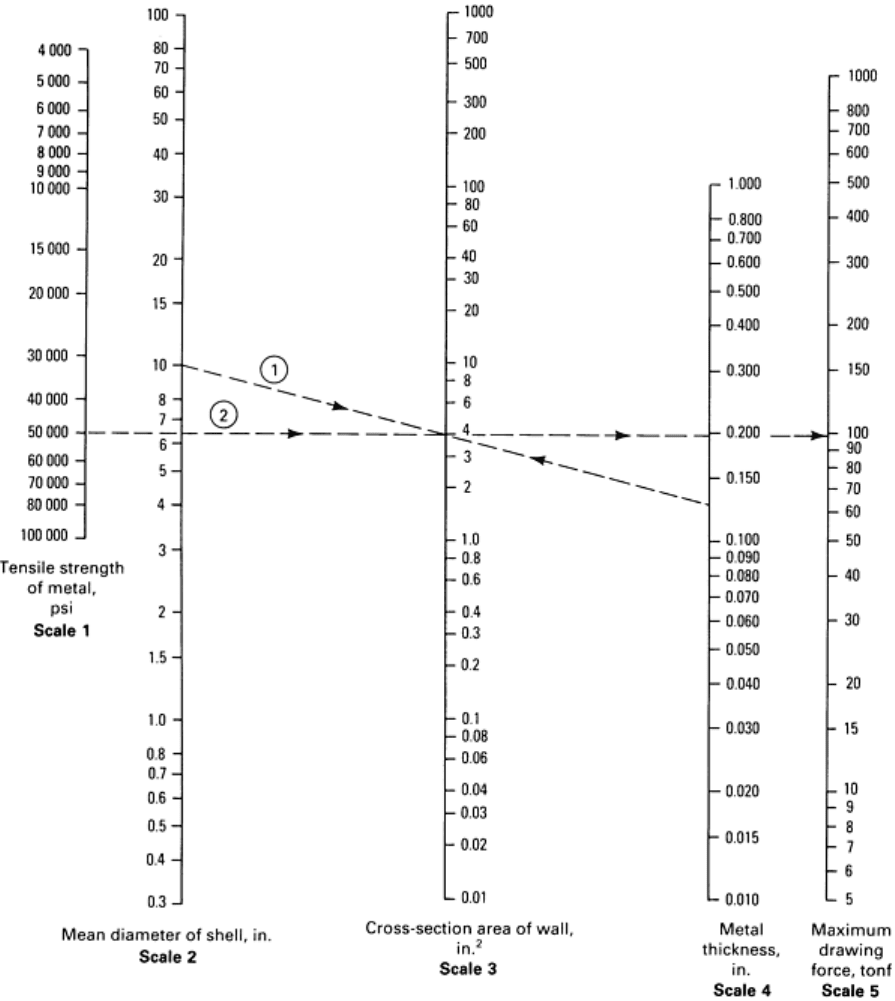
Fig. 3 Nomograph used for estimating drawing force based on several parameters.
See text for description of
use.
The force required to draw a rectangular cup can be calculated using Eq 7:
F
d,max
= ts
u
(2πRk
a
+ Lk
b
)
(Eq 7)
where R is the corner radius of the cup (in inches), L is the sum of the lengths of straight sections of the sides (in inches),
k
a
and k
b
are constants, and the other quantities are as defined in Eq 6. Values for k
a
range from 0.5 for a shallow cup to
2.0 for a cup with a depth five to six times the corner radius; k
b
values range from 0.2 (for easy draw radius, ample
clearance, and no blankholder force) to a maximum of 1.0 (for metal clamped too tightly to flow).

When blankholder cylinders are mounted on the main slide of the press, the blankholder force must be added to the
calculated drawing force. When a die cushion is used to eject workpieces, the main slide works against this force;
therefore, such setups require more drawing force than would be calculated using Eq 6 or 7.
In toggle draw presses, the blankholder force is taken on the rocker shaft bearings in the press frame, so that the
crankshaft bearings sustain only the drawing load. In other types of presses, both the drawing and blankholding loads are
on the crankshaft, and allowances are made when computing press capacity. For round work, the allowance for
blankholding should be 30 to 40% of the drawing force. For large rectangular work, the drawing force is relatively lower
than that for round work, but the blankholding force may be equal to the drawing force. Where stretching is involved and
the blank must be gripped tightly around the edge (and a draw bead is not permissible), the blankholding force may be
two or three times the drawing force.
Blank size governs the size of the blankholder surfaces. Some presses with sufficient force cannot be considered for
deep drawing, because the bed size and shut height are inadequate.
Depth of Draw. The length of stroke and the force required at the beginning of the working portion of the stroke are
both important considerations. Parts that have straight walls can often be drawn through the die cavity and then stripped
from the punch and ejected from the bottom of the press. Even under these ideal conditions, the minimum stroke will be
equal to the sum of the length of the drawn part, the radius of the draw die, the stock thickness, and the depth of the die to
the stripping point, in addition to some clearance for placing the blank in the die.
Workpieces with flanges or tapered walls must be removed from the top of the die. In drawing these workpieces, the
minimum press stroke is twice the length of the drawn workpiece, plus clearance for loading the die. In an automatic
operation using progressive dies or transfer mechanisms, at least one-half the stroke must be reserved for stock feed
because the tooling must clear the part before feeding begins for the next stroke. For automatic operation, it is common
practice to allow a press stroke of four times the length of the drawn workpiece. Therefore, some equipment is not suited
to automatic operation, or it is necessary to use manual feed with an automatic unloader, or conversely, because of a
shortage of suitable presses.
Slide Velocity. When selecting a press, it is also necessary to check slide velocity through the working portion of the
stroke (see the section "Effect of Press Speed" in this article).
Means of Holding the Blank. Double-action presses with a punch slide and a blankholder slide are preferred for deep
drawing. Single-action presses with die cushions (pneumatic or hydraulic) can be used, but are less suitable for drawing
complex parts. Draw beads are incorporated into the blankholder for drawing parts requiring greater restraint of metal
flow than can be obtained by using a plain blankholder or for diverting metal flow into or away from specific areas of the
part (see the section "Restraint of Metal Flow" in this article).
Selection Versus Availability. The ideal press equipment for a specific job is often not available. This makes it
necessary to design tools and to choose product forms of work metal in accordance with available presses and
supplementary equipment. For example, if available presses are not adequate for drawing large workpieces, the
manufacturing sequence must be completely changed. It may be necessary to draw two sections and weld them together.
In addition, operations that could otherwise be combined, such as blanking, piercing, drawing, and trimming, may have to
be performed singly in separate presses.
On the other hand, some manufacturers have placed more than one die in a single press because of the availability of a
large press and the shortage of smaller presses. This procedure can cause lower production because all blanks must be
positioned before the press can be operated. However, storage of partly formed workpieces and additional handling
between press operations are eliminated. Where several small dies are used to reduce overall tool cost, there is economic
justification for the use of small-capacity presses. If small presses are not available, it is often more economical to use
compound dies. This is particularly true if overall part production is likely to exceed original estimates.
The availability of auxiliary equipment may also influence the type of press and tooling used. For example, if equipment
is available for handling coils, plans will be made accordingly. However, if coil-handling equipment is not available and
straight lengths of sheet or strip are to be processed, a compatible tooling procedure must be used, even though it might
not be the most economical procedure.
Deep Drawing
